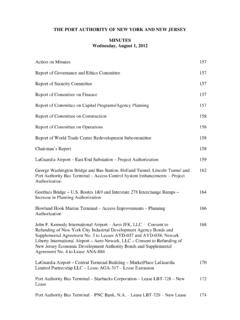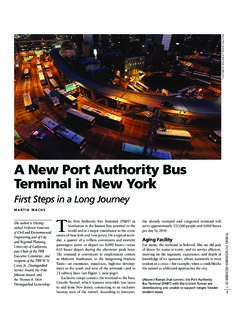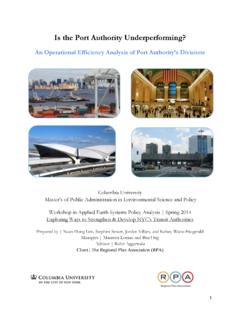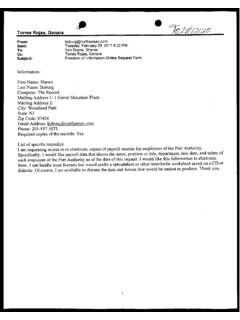Transcription of RUNNING EXPRESS - DePaul University, Chicago
1 RUNNING EXPRESS2017 Outlook for the IntercityBus Industry in the United StatesCHADDICK INSTITUTE FOR METROPOLITAN DEVELOPMENT AT DePaul UNIVERSITY | POLICY SERIESBY BRIAN ANTOLIN & JOSEPH P. SCHWIETERMAN* | JANUARY 13, 20172017 CHADDICK INSTITUTE FOR METROPOLITAN DEVELOPMENT AT DePaul UNIVERSITY CONTACT: JOSEPH SCHWIETERMAN, | PHONE: | EMAIL: ANTOLIN AND JOSEPH P. SCHWIETERMAN* RILEY O NEIL AND DANA YANOCHA DATACOLLECTIONAUTHORSTHE STUDY TEAMRACHAEL SMITHGRAPHICS FROM TOP RIGHT, COUNTER CLOCKWISE: PHOTO BY ROB YOUNG, HUSSEIN ABDALLAH, EDDIE (USERNAME), AND STEVENS.
2 ALL PHOTOS LICENSED UNDER CREATIVE COMMONS. PHOTOGRAPHY*CORRESPONDING AUTHORVERSION 2 1 Intercity bus lines rolled into the new year with an improved short-term outlook due to several factors: a slowly recovering economy, upward movement in the cost of gasoline, and growing customer awareness of new tech-oriented service enhancements. Several potentially disruptive forces, however, loom on the horizon. This report summarizes the intercity bus industry s performance and competitive status. Part I provides insights into what can be expected to affect the sector over the next several years based on a review of notable trends.
3 Part II explores the evolving competitive landscape of the intercity bus industry, including the prevalence of EXPRESS bus service in the country s most heavily-traveled markets. I. SHORT-TERM OUTLOOK FOR THE INTERCITY BUS INDUSTRY The following trends are sources of both optimism and uncertainty for scheduled intercity bus travel. TREND 1: Years of relatively flat traffic and passenger revenues culminated in targeted cuts by prominent carriers in 2016, but revenues from passenger operations appear on an upward trajectory and are likely to grow around three percent this year.
4 Several factors, including an uptick in the price of fuel, suggest that market forces that have marginalized the growth in bus traffic are subsiding. The past two calendar years have shown trying times for scheduled intercity operators. Relatively low fuel prices nullified some of the advantages of being a fuel-efficient major mode of intercity ground travel. Automobile competition intensified as a result, with the national average price of gasoline staying below $ throughout all of Airline prices remained at their lowest levels in years, with average roundtrip ticket prices falling to $ in 2016, down almost $20 from 2015, apparently hurting bus travel on routes in which flying is an Worst-case scenarios about long TSA security lines failed to materialize.
5 Finally, a downturn in rail-freight traffic significantly improved Amtrak s on-time performance, luring some short-hop passengers away from buses. Nevertheless, recent signals have been encouraging. Most notably, the price of oil has gradually moved upward, rising from around $ in January 2016, to $ in June, to more than $52 in early 2017. The economy is also improving, resulting in a reduced unemployment rate, which fell from in February to in November. While GDP grew by only about last year, the Federal Open Market Committee projects growth at around in The lackluster rate of economic growth in recent years surely affected the financial performance of major bus lines.
6 Results published by FirstGroup, converted from pound sterling to dollars, indicate that its subsidiary, Greyhound Lines, had about a 4% drop in revenues during its 2016 fiscal year (which ended June 30). Our analysis suggests that passenger revenues were down closer to 5% (an estimate subject to rounding error).4 Meanwhile, conversions to dollars indicates that ( Megabus ), a unit of Scotland-based Stagecoach Group, had about a 9% drop in revenue from North American operations, although the holding company s total revenues in this region were down much less.
7 These estimates may be affected by swings in the exchange rate over the course of the year, which are not taken into account5. 2 Despite falling revenues from these two national providers, the number of passengers and passenger miles of travel on these and other carriers appears to have fallen by a much smaller margin, and in some cases even rose slightly. Some of the revenue drop appears to be attributable to price discounting in a hotly competitive environment rather than declining demand. As noted in previous Chaddick Institute annual intercity bus reviews, accurate estimates of bus traffic remain elusive due to the absence of comprehensive reporting requirements.
8 We estimate that total intercity bus travel stayed relatively constant, at about 62 million passengers annually, making the sector about twice the size of Amtrak. Please refer to last year s report for a summary of methods used to make this earlier estimate. Only a small number of routes were cut in 2016 despite these difficult conditions. Citing rising automobile competition, Megabus discontinued its Cleveland, OH to Atlanta, GA service in February. Launched by Coach USA subsidiary, Lakefront Lines, before being rebranded, this twice-daily service consisted of single level coaches operating via Columbus, Cincinnati, OH, and Knoxville, TN.
9 More significantly, Megabus downsized its Chicago hub, eliminating its route to Omaha in turn ending service to Iowa City and Des Moines as well as service to East Lansing, MI, in early 2017. These cuts, as well as selected routes in Florida, mark Megabus most significant downsizing in recent years. Citing similar concerns, Bieber Tourways discontinued service to Pottsville and Schuylkill Haven, PA, along its Reading to Philadelphia route, while also reducing weekday frequency from five to four trips. Peter Pan Bus Lines pointed to soft demand before discontinuing its Sturbridge, MA-area stops along its Springfield to Boston route.
10 Frequency on most other routes across the country maintained firm, while some corridors experienced modest expansion, as noted below. Greyhound appears to have adjusted to demand conditions largely by reducing the number of extra sections operated on major routes. Several factors suggest that revenues have begun rebounding and that this trend will continue through 2017 and 2018: A consensus exists among commodity analysts that fuel prices will move closer to the $55 range by late 2017. Prices in this range have spurred many travelers to turn to bus travel due to the higher costs of driving and air travel.










